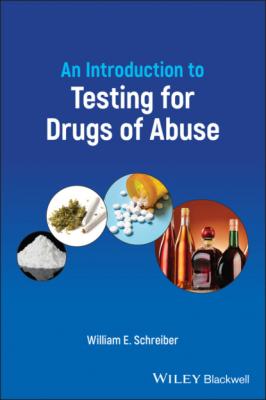An Introduction to Testing for Drugs of Abuse. William E. Schreiber
Читать онлайн.| Название | An Introduction to Testing for Drugs of Abuse |
|---|---|
| Автор произведения | William E. Schreiber |
| Жанр | Химия |
| Серия | |
| Издательство | Химия |
| Год выпуска | 0 |
| isbn | 9781119794073 |
Figure 1.2 Costs of substance use in Canada in 2017. For each substance, the estimated cost is given (a) in billions of dollars and (b) as a percentage of the total cost. The costs attributable to healthcare, lost productivity, the criminal justice system, and other direct costs are indicated.
Source: Adapted with permission from the Canadian Centre on Substance Use and Addiction, 2021.
The overall cost of substance use in Canada in 2017 was estimated at $46 billion. This amount was attributed to lost productivity (43.5%), healthcare (28.4%), criminal justice (20.1%), and other direct costs (7.9%). Figure 1.2 shows the absolute and relative cost for each substance – more granular detail is provided on pages 8–10 of the report.
Controlled Substance Schedules
Government agencies classify drugs and certain chemical compounds according to their acceptable medical use as well as their potential for abuse and harm. In the United States, the Drug Enforcement Administration (DEA) lists drugs under five distinct categories or schedules. The definition of each schedule and some examples are given in Table 1.1. A more complete list of controlled substances is available on the DEA website:
www.deadiversion.usdoj.gov/schedules/
In Canada, the Controlled Drugs and Substances Act is the national law that governs production, sale, import, export, and possession of controlled substances and precursors. Individual drugs and drug groups are listed in a series of appended schedules. The Act and its schedules appear on the Justice Laws website of the Government of Canada:
https://laws‐lois.justice.gc.ca/eng/acts/C‐38.8/
Table 1.1 Controlled substance schedules in the United States.
Source: Drug scheduling, United States Drug Enforcement Administration, www.dea.gov/drug‐scheduling.
| Definition | Examples |
|---|---|
| Schedule I | |
| Drugs with no currently accepted medical use and a high potential for abuse | Heroin |
| Marijuana (cannabis) | |
| LSD peyote | |
| MDMA | |
| Schedule II | |
| Drugs with a high potential for abuse, with use potentially leading to severe psychological or physical dependence | Cocaine |
| Methamphetamine | |
| Methadone | |
| Oxycodone | |
| Fentanyl | |
| Schedule III | |
| Drugs with a moderate to low potential for physical and psychological dependence | Codeine‐containing products (90 mg or less per dosage unit) |
| Ketamine | |
| Anabolic steroids | |
| Schedule IV | |
| Drugs with a low potential for abuse and low risk of dependence | Diazepam |
| Propoxyphene | |
| Tramadol | |
| Zolpidem | |
| Schedule V | |
| Drugs with lower potential for abuse than Schedule IV. These preparations contain limited quantities of certain narcotics and are generally used for antidiarrheal, antitussive, and analgesic purposes | Cough preparations with codeine (200 mg or less per 100 mL) |
| Lomotil® (atropine/diphenoxylate) | |
| Pregabalin | |
LSD, lysergic acid diethylamide; MDMA, 3,4‐methylenedioxymethamphetamine (ecstasy).
Why Test for Drugs of Abuse?
There are several fields of medicine in which drug testing is an essential part of diagnosis and monitoring.
Emergency medicine – patients with an acute intoxication may present with aggressive or bizarre behavior or an altered level of consciousness. Testing for alcohols and other substances in blood helps the physician to identify the cause and monitor treatment. Screening for drugs in urine can identify recent consumption of commonly abused drugs and assist in follow‐up care.
Addiction medicine – treatment of substance use disorders usually requires monitoring of patients for ongoing consumption of drugs. For example, patients on a methadone maintenance program are monitored to ensure that they are taking the methadone as prescribed and are not continuing to use other opioids. Treatment of alcohol use disorder includes testing for markers of alcohol consumption.
Pain management – opioids and other medications are prescribed to treat chronic pain syndromes. Patients may sell or divert their medications, becoming distributors of pharmaceutical‐grade drugs to others who misuse them. Regular testing is performed to ensure compliance with the treatment program and to check for use of nonprescribed medications.
Drug testing is also performed to promote safety in the workplace, support the legal system, and ensure fair competition in sports.
Workplace drug testing – drug use among employees is responsible for time lost from work and increased numbers of job‐related accidents. Intoxicated employees are more likely to cause injury or death to themselves, their coworkers and innocent third parties. The transportation industry regularly tests drivers, pilots, and other workers for drug use to maintain standards of safety and accountability. Cut‐off concentrations for initial and confirmatory tests are published by the United States Department of Transportation (Table 1.2).
Forensic toxicology – this term refers to drug analysis for legal purposes. Testing of drivers for ethanol and other drugs is used to establish intoxication, which may lead to arrest, prosecution, and civil or criminal penalties. People may be given drugs without their knowledge to incapacitate them for purposes of robbery or sex (drug‐facilitated assault). Analysis of the victim's blood or urine can identify such drugs. Toxicology is also a standard part of death investigations conducted by coroners and medical examiners. Postmortem analysis for drugs in blood, urine, and vitreous specimens is routinely performed to investigate a possible drug‐related cause of death.
Performance
